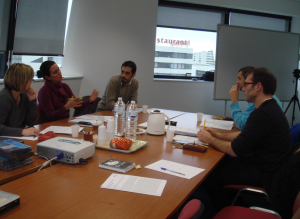On this page, the guidelines for facilitating Participatory Design sessions are described.
During a session, you should try to create a non-formal and relaxed atmosphere. A cup of coffee or soft-drink for all can relax the situation. There are no right or wrong answers, let the teachers and students talk. Do not stop or guide them, even if they are presenting ideas that you consider irrelevant. Still, give everyone a chance to speak and encourage the quiet participants to make sure that no one dominates the discussion.
FOR PREPARATION, translate the scenarios that you will cover in your sessions into the native language of the teacher and student participants. Then, recruit 2-3 teachers and students and book a place and time for the session. You can invite teachers and students who participated before, new teachers and students, or a mix of both. You can choose to either facilitate separate sessions with teachers and students or to mix them in one session.
The total amount of PARTICIPANTS includes 1 researcher/designer, 2-3 teachers, 2-3 students.
The EQUIPMENT you need includes:
- Note book and pen for your notes
- Blank paper and pens for all participants
- Digital camera and digital audio recorder + microphone for documentation (a video camera is a possible alternative)
- Printouts of the scenarios (same amount as total amount of participants, including you)
- Printouts of the two comic strips: Comic Strip 1 and Comic Strip 2
THE SPACE should be the teachers’ and students’ authentic working environment, such as a classroom or a teacher office. The space should be quiet and private with chairs and tables for writing and possible drawing. An unoccupied classroom is perfect for a session.
TIME: One session should last about of 2-3 hours.
THE PROCESS includes 5 stages: (1) Breaking the ice, (2) Talking about the scenarios, (3) Gathering specific design ideas, (4) Wrapping up, and (5) After the session. These are described here.
1. Breaking the ice
- Introduce yourself and the iTEC project. It is sufficient to say mention the name and that iTEC is a European research and development project.
- Explain that this session is facilitated as a discussion about advanced learning scenarios. The aim of the session is to gather early ideas on what kind of technology the teachers and students would like to use, and on what kind of activities work in their classroom context.
- Tell participants that you are going to record the session and take pictures, but that the material will be used only for research and design purposes.
- Tell that you have some scenarios that you want the teachers and students to read and talk about together after the reading.
- Press “record” on your digital audio recorder.
- Ask the teachers and students some basic information: How long they have worked as a teacher? How long have they been at this school? How long they have used computers in their teaching or learning?
- For ice breaking and for forgetting the audio recording, show the comic strips: Comic Strip 1 and Comic Strip 2. Ask what did they think about the strips? Was it funny? Why? Is this kind of discussions common among students? Take a picture of the teachers and students looking the strips, and include the space. If you are working with teachers students who know each other, or if they are comfortable with the recording and the atmosphere is already relaxed, you may skip this step.
2. Talking about the scenarios
- Give the first scenario to the teachers and students (one copy for each) to read.
- Questions: Did the story generate any thoughts? Is this a possible story? Is there something they would like to change in it? Could they imagine themselves in the role of the teacher/learner? What part would they find most difficult to manage if they were in the role of the teacher/learner? How would the story continue?
- Make sure that each participant replies to each question.
- Take pictures of the participants talking about the scenarios.
- Repeat the steps above with all scenarios.
3. Gathering specific design ideas
- Ask the teachers and students what kind of technology they think we will develop in the project. Can they explain what the system should be able to do and be like?
- Encourage them to illustrate their explanation with drawings or diagrams of it. Use pen and paper.
- Take pictures of the teachers and students explaining their stories.
4. Wrapping up
- Ask the teachers and students for their email addresses and ask if we may ask them more questions later.
- Take pictures of everyone.
- Thank everyone for their effort.
5. After the session
- At the end of the session you should have an audio recording of about 2 hours and 10-20 pictures of the session.
- Please check the Participatory design results -page for instruction on how to report and share the results of the session.
This post is also available in: Turkish









